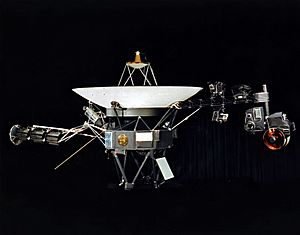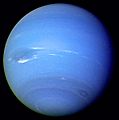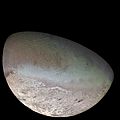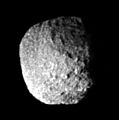Exploration of Neptune facts for kids
The exploration of Neptune began on August 25, 1989. On that day, a spacecraft called Voyager 2 made history. It was the first, and so far only, spacecraft to ever visit Neptune.
Neptune is a gas giant planet. This means it does not have a solid surface like Earth. So, landing a spacecraft on Neptune would be impossible.
NASA is thinking about sending another spacecraft to Neptune. It might be called the Neptune Orbiter. This mission could launch around 2030 or 2035. It would study Neptune even more closely. The mission might also send small probes into Neptune's atmosphere. There's even a chance it could send a lander to Triton, one of Neptune's moons.
Contents
Voyager 2: Our First Visit to Neptune
Voyager 2 made its closest approach to Neptune on August 25, 1989. It flew about 3,000 miles (5,000 km) above Neptune's north pole. This was the closest Voyager 2 had been to any planet since leaving Earth.
This amazing spacecraft studied many parts of Neptune. It looked at Neptune's atmosphere, its rings, and its magnetosphere. It also studied Neptune's many moons. Voyager 2 made some exciting discoveries. These included the Great Dark Spot and geysers on Triton.
Neptune's Active Atmosphere
Voyager 2 found that Neptune's atmosphere is very active. This was surprising because Neptune gets very little sunlight. It receives only about 3% of the sunlight that Jupiter gets.
Voyager 2 discovered a huge storm on Neptune. It was like a giant hurricane. Scientists called it the Great Dark Spot. It was similar to Jupiter's Great Red Spot. However, later pictures from the Hubble Space Telescope showed that the Great Dark Spot had disappeared.
Voyager 2 also saw other features in Neptune's atmosphere. One was an almond-shaped spot called "D2". Another was a bright, fast-moving cloud. It was high above the other clouds and was named "Scooter".
Rings and Magnetism
Voyager 2 also found four rings of Neptune around Neptune. It also found proof of "ring arcs". These are like incomplete rings. They are not full circles around the planet.
The spacecraft also studied Neptune's magnetosphere. This is the area around a planet where its magnetic field is strong. Voyager 2's instruments helped figure out how long a day is on Neptune. It is sixteen hours and seven minutes long. Voyager 2 also discovered auroras on Neptune. These are like the northern and southern lights we see on Earth. But Neptune's auroras are much more complex.
Neptune's Moons
Voyager 2 discovered six new moons orbiting Neptune. However, it only took detailed pictures of three of them. These were Proteus, Nereid, and Triton.
- Proteus: This moon turned out to be very dark. It is shaped like an ellipsoid. This is as large as a moon can get before its own gravity pulls it into a perfect sphere.
- Nereid: This moon was discovered in 1949. But even after Voyager 2 flew by, we still don't know much about it.
- Triton: Voyager 2 flew about 25,000 miles (40,000 km) from Triton. This was the last object Voyager 2 would explore. Triton was shown to have amazing active geysers. These shoot out icy material. It also has polar caps made of frozen gases. A very thin atmosphere was found around Triton, along with thin clouds.
Related pages
Images for kids





